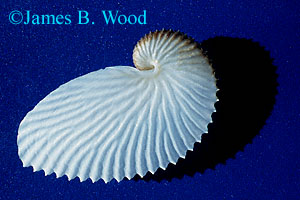Argonauta nodosa, Paper nautilus
<< Cephalopod Species
 The paper nautiluses, Argonauta sp., are not nautiluses at all, they are octopuses! The paper thin white calcareous 'shell' is actually an egg case made by females. These delicate 'shells' are prized rare finds to beach combers. Argonauts are found worldwide in tropical and semi-tropical waters but they are quite rare. However, every now and then large numbers of them will be found in certain areas of the world. Australians seem to be especially blessed.
The paper nautiluses, Argonauta sp., are not nautiluses at all, they are octopuses! The paper thin white calcareous 'shell' is actually an egg case made by females. These delicate 'shells' are prized rare finds to beach combers. Argonauts are found worldwide in tropical and semi-tropical waters but they are quite rare. However, every now and then large numbers of them will be found in certain areas of the world. Australians seem to be especially blessed.
Argoanuts are open-ocean cephalopods and we really don't know much about them. They are hard to find, so far they seem to be unpredictable in occurance and to my knowledge no one has kept one alive in an aquarium for more than two weeks. In addition to small crustaceans, they injest some types of prey that most other cephalopods wouldn't consume such as salps and jellyfish. They are very interesting cephalopods from both an aestetic and a biological point of view.
 Argonauts are one of the most sexually dimorphic cephalopods. The females are considerably larger than the males. Females are thought to live longer and reproduce many times while the tiny males are thought to only reproduce once and have much shorter life spans. During mating, one of the male's arms breaks off inside the mantle of the female. So both size and life span are radically different between the sexes. Argonauts are one of the most sexually dimorphic cephalopods. The females are considerably larger than the males. Females are thought to live longer and reproduce many times while the tiny males are thought to only reproduce once and have much shorter life spans. During mating, one of the male's arms breaks off inside the mantle of the female. So both size and life span are radically different between the sexes.
Hundereds of years ago early scientists thought the broken off male reproductive arm was a seperate parasitic creature and they named it a Hectocotylus. This name continues to be used today for the modified reproductive arm of male cephalopods—often this is the third arm on the right. There is a pervasive rumor that the reproductive arm of all male octopuses breaks off during copulation; this is true for Argonauts but is not true for other octopuses.
The photograph to the right is of a 5 cm long juvenile Argonauta nodosa from Victoria, Australia.
Credits
Thanks to David Paul for providing a photograph of this beautiful animal in the wild. Remember, all images on The Cephalopod Page are protected by international copyright laws and may not be used for any purpose without permission from their photographer.
|


 The paper nautiluses, Argonauta sp., are not nautiluses at all, they are octopuses! The paper thin white calcareous 'shell' is actually an egg case made by females. These delicate 'shells' are prized rare finds to beach combers. Argonauts are found worldwide in tropical and semi-tropical waters but they are quite rare. However, every now and then large numbers of them will be found in certain areas of the world. Australians seem to be especially blessed.
The paper nautiluses, Argonauta sp., are not nautiluses at all, they are octopuses! The paper thin white calcareous 'shell' is actually an egg case made by females. These delicate 'shells' are prized rare finds to beach combers. Argonauts are found worldwide in tropical and semi-tropical waters but they are quite rare. However, every now and then large numbers of them will be found in certain areas of the world. Australians seem to be especially blessed.
